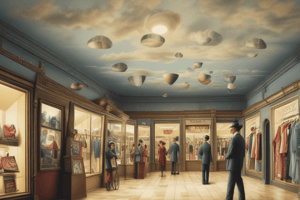Podcast
Questions and Answers
What is one advantage of visual merchandising mentioned in the text?
What is one advantage of visual merchandising mentioned in the text?
- Increases raw material costs
- Improves employee satisfaction
- Enhances overall customer satisfaction (correct)
- Reduces the need for advertisements
How fast can humans recognize shapes according to the text?
How fast can humans recognize shapes according to the text?
- Within one second
- Within ten milliseconds (correct)
- Within one hour
- Within one minute
Which strategy helps guide shopper flow throughout a store, as per the text?
Which strategy helps guide shopper flow throughout a store, as per the text?
- Avoiding clear signage
- Using dull colors
- Having cluttered displays
- Creating eye-catching focal points (correct)
What is a key focus in successful visual merchandising design according to the text?
What is a key focus in successful visual merchandising design according to the text?
How does visual merchandising help promote brand identity?
How does visual merchandising help promote brand identity?
What is one reason why visuals are important in engaging customers according to the text?
What is one reason why visuals are important in engaging customers according to the text?
What is the primary goal of visual merchandising?
What is the primary goal of visual merchandising?
Which historical period saw the use of live animals as part of visual merchandising displays?
Which historical period saw the use of live animals as part of visual merchandising displays?
What are some elements encompassed by visual merchandising?
What are some elements encompassed by visual merchandising?
How does visual merchandising contribute to retail success?
How does visual merchandising contribute to retail success?
What was a common practice in medieval European markets related to visual merchandising?
What was a common practice in medieval European markets related to visual merchandising?
What distinguishes visual merchandising from regular product display?
What distinguishes visual merchandising from regular product display?
Flashcards are hidden until you start studying
Study Notes
Retailing's Visual Appeal: Unlocking the Power of Visual Merchandising
Visual merchandising is a strategic approach employed by retailers worldwide to present products in captivating ways, showcasing their unique attributes through artful displays. This practice has been honed over centuries, with its roots tracing back to medieval European markets and bazaars where sellers created enticing scenes to attract customers. In today's competitive landscape, merchants continue to leverage this method to deliver memorable shopping experiences, drive sales, and stay relevant amidst ever-evolving consumer preferences.
What Is Visual Merchandising?
Simply put, visual merchandising refers to arranging, displaying, lighting, packaging, signage, and promoting products in stores so they appear aesthetically appealing, capture shoppers' attention, and ultimately encourage purchases. It encompasses various elements such as store layout design, mannequin styling, color selection, creative window displays, product placement strategies, and more.
History & Evolution of Visual Merchandising
During the Middle Ages, market stalls were set up along bustling streets, featuring intricate arrangements of wares designed to appeal to passersby. As retail evolved into department stores during the Victorian era, elaborate displays became commonplace, often incorporating props, models, and even live animals to pique curiosity and boost brand perception. By World War I, interior spaces had become increasingly important as mass production enabled the creation of more diverse products.
In contemporary times, technological advancements have introduced novel techniques like augmented reality windows and interactive digital screens, further enhancing the customer experience while allowing retailers to express creativity.
Why Visuals Matter
Our brains process images much faster than text; humans can recognize colors within one tenth of a second and shapes within just ten milliseconds. This innate ability makes visual merchandising essential when it comes to engaging customers in our fast-paced world. Visual merchandising helps promote brand identity, improve product recognition, create emotional connections between consumers and products, increase impulse buying opportunities, and enhance overall customer satisfaction.
Best Practices for Successful Visual Merchandising
Designing an effective visual merchandising strategy involves patience and experimentation, as each retailer must tailor their efforts according to target audience demographics and specific business goals. However, some general best practices may help lay the foundation for success:
- Highlight focal points: Create eye-catching focal points within your displays, using well-lit areas, clear signage, and vibrant colors to draw attention and guide shopper flow throughout the store.
- Tell stories: Share narratives with your customers – convey the inspiration behind new collections, tell the story of designers, or emphasize environmentally friendly initiatives.
- Go beyond traditional displays: Experiment with innovative methods such as moving projections, holograms, or automated systems yet to be fully embraced by mainstream retailers.
The power of visual merchandising lies in its potential to elevate everyday objects, transform them into desirable items, while simultaneously providing unforgettable shopping experiences. With constant evolution and innovation, this crucial aspect remains central to the ongoing success of brick-and-mortar retail establishments everywhere.
Studying That Suits You
Use AI to generate personalized quizzes and flashcards to suit your learning preferences.




